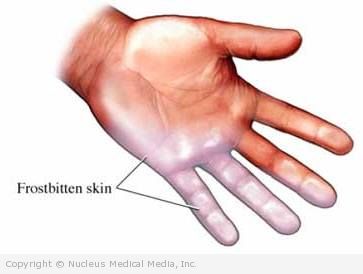Frostbite – Definition
Frostbite is frozen water in body tissues. Like burns, frostbite injuries can be ranked in severity. First-degree frostbite is the mildest. Fourth-degree frostbite is the most severe. It may result in loss of the affected body part.
The most common parts of the body to become frostbitten include:
- Fingers
- Toes
- Ears
- Nose
- Hands
- Feet
- Lips
- Shins
- Cheeks
- Corneas
- Causes
Frostbite happens when skin is exposed to freezing temperatures. This can cause the body tissue to freeze. Ice crystals actually form within the frozen body part. Blood cannot flow adequately through the frozen tissue. This causes the frozen tissue to be deprived of blood and oxygen. The combination of freezing and oxygen deprivation causes tissue damage or tissue death. Rewarming may also ultimately lead to tissue death.
Frostbite – Risk Factors
Factors that increase your chance for frostbite include:
- Exposure to freezing temperatures without adequate covering
- Low body temperature ( hypothermia)
- Age: very young or very old
- Homelessness
- Fatigue
- History of previous cold weather injury
- High-altitude cold exposure
- Working in freezing conditions
- Participating in winter sports or high-altitude sports
- Wearing wet clothing
- Suffering from a condition that affects your mental status, such as:
- Head injury
- Mental illness
- Use of mind-altering drugs or alcohol
- Inability to move
- Using drugs that cause your blood vessels to become constricted (such as nicotine)
- Medical conditions, such as:
- Malnutrition
- Thyroid problems
- Infection
- Disease of the blood vessels
- Arthritis
- Diabetes
Frostbite – Symptoms
Symptoms include:
- Swelling
- Coldness or firmness of tissue
- Clumsiness
- Waxy appearance of the skin
- Color ranging from red to white to blue, depending on severity
- Blisters that may be filled with clear or bloody fluid
- Numbness, stinging, burning, or tingling
- Joint pain
Frostbite – Diagnosis
The doctor will ask about your symptoms and medical history. A physical exam will be done. Diagnosis is usually based on symptoms and the findings of the physical exam.
Frostbite – Treatment
Rapid rewarming in a warm (100°F to 110°F) water bath is the treatment of choice. Slow rewarming may cause more tissue damage.
If you are stranded with frostbite and unable to get medical help:
- Try to get to a warm location. Wrap yourself in blankets.
- Do not put snow or hot water on the injured area.
- Do not rub affected areas.
- Tuck your hands into your armpits to try to rewarm them.
- If it’s available, use warm water (at about 105°F [40°C]) to rewarm your frostbitten area.
- Avoid refreezing the affected area. This can result in more severe injury.
- Walking on frozen feet and toes can cause damage. It may be more important to find shelter.
- Drink warm liquids.
- Avoid alcohol and sedatives.
- Cover the injured area with a clean cloth until you can get medical help.
- Rewarming can be intensely painful. To relieve pain take:
- Aspirin
- Acetaminophen (Tylenol)
- Ibuprofen (Advil, Motrin)
If you’re able to get medical assistance, treatment may include moving you to a warm place and wrapping you in blankets. The injured body part may be soaked in warm (not hot) water.
Other treatments may include:
- Opening and emptying blisters.
- Taking antibiotics.
- Taking pain medication.
- Keeping the injured body part elevated above your heart.
- Getting a tetanus booster shot.
- Receiving hyperbaric oxygen therapy. This is a special chamber under greater pressure than normal. It will help with blood flow and tissue repair.
- Amputation of all or part of the affected body part. This may be necessary in severe frostbite cases.
If you are diagnosed with frostbite, follow your doctor’s instructions.
Frostbite – Prevention
To help prevent frostbite, dress properly when going outside in cold weather. For example:
- Cover your head, face, hands, and feet adequately.
- Wear layers of clothing.
- Wear materials that provide good insulation. It should keep moisture away from the skin. (eg, wool, polyester, polypropylene)
- Make sure you wear a waterproof outer layer and stay dry.
- Avoid drinking alcohol when you will be in cold weather.

